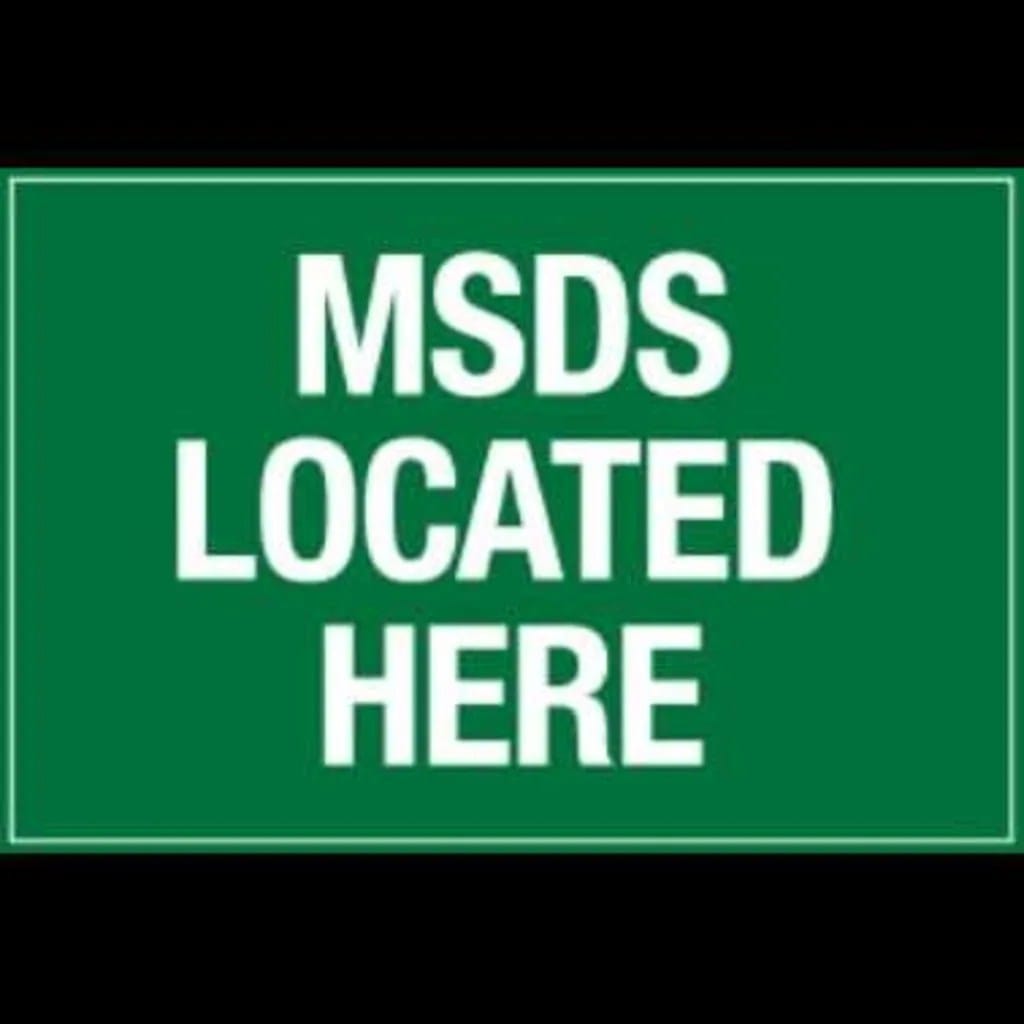Working with chemicals, from household cleaners to industrial solvents, requires understanding potential hazards. Safety Data Sheets (SDSs), formerly known as Material Safety Data Sheets (MSDSs), provide essential safety information. This comprehensive guide explains what SDSs are, where to find them, and how to use them effectively, empowering you to protect yourself, your colleagues, and the environment.
Understanding SDS: Your Chemical Safety Manual
SDSs are detailed documents providing comprehensive information about a chemical’s properties, hazards, safe handling practices, and emergency procedures. Think of them as a user manual for handling chemicals safely. They offer crucial insights, helping you make informed decisions about the chemicals you use, both at work and at home.
The Transition from MSDS to SDS: Embracing Global Standards
The Globally Harmonized System (GHS) of Classification and Labelling of Chemicals brought about a significant shift in chemical safety data presentation. It introduced the standardized 16-section SDS format, replacing the less consistent MSDS format. While the term “MSDS” is still commonly used, “SDS” is the current global standard. This shift ensures a consistent, internationally recognized format, enhancing communication and safety worldwide.
Decoding the 16 Sections: A Wealth of Information
Each section of an SDS provides specific information crucial for safe chemical handling:
- Identification: Product identifier, manufacturer/distributor information, recommended use, and restrictions on use.
- Hazard(s) identification: Hazard classification, label elements (pictograms, signal words, hazard statements), precautionary statements, and other hazards not otherwise classified.
- Composition/information on ingredients: Information on the chemical ingredients, including impurities and stabilizing additives.
- First-aid measures: Description of necessary first-aid measures following exposure, including specific symptoms and immediate treatment.
- Fire-fighting measures: Suitable extinguishing media, specific hazards arising from the chemical, special protective equipment and precautions for firefighters.
- Accidental release measures: Personal precautions, environmental precautions, containment and cleanup methods.
- Handling and storage: Precautions for safe handling, specific conditions for safe storage, including incompatibilities.
- Exposure controls/personal protection: Occupational exposure limits, engineering controls, personal protective equipment (PPE) recommendations.
- Physical and chemical properties: Appearance, odor, important health, safety and environmental information including pH, flashpoint, etc.
- Stability and reactivity: Chemical stability, possibility of hazardous reactions, conditions to avoid (e.g., static discharge, shock, or heat), incompatible materials.
- Toxicological information: Information on likely routes of exposure, symptoms related to the physical, chemical and toxicological characteristics, and delayed and immediate effects.
- Ecological information (Non-mandatory): Ecotoxicity (aquatic and terrestrial), persistence and degradability, bioaccumulative potential, mobility in soil, other adverse effects.
- Disposal considerations (Non-mandatory): Description of waste residues and information on their safe handling and methods of disposal, including any applicable regulations.
- Transport information (Non-mandatory): UN number, UN proper shipping name, transport hazard class(es), packing group, environmental hazards (e.g., marine pollutant), special precautions for user.
- Regulatory information (Non-mandatory): Safety, health and environmental regulations specific for the product in question.
- Other information: Date of preparation or last revision, any other relevant information not included in previous sections.
Locating SDS: Where to Find These Vital Documents
Accessing SDSs is crucial for ensuring workplace safety. They can be found in various locations:
Workplace Access: Your Employer’s Responsibility
Employers are legally obligated, under OSHA’s Hazard Communication Standard (29 CFR 1910.1200), to provide readily accessible SDSs for all hazardous chemicals present in the workplace. This access must be available to all employees potentially exposed to the chemicals during all work shifts. Usual locations include:
- Designated Safety Stations: Often found alongside first-aid kits and other emergency supplies.
- SDS Binders: While a traditional method, binders can be cumbersome to update.
- Company Intranet: Many companies provide digital SDS libraries on their internal networks.
- SDS Management Software: Specialized software offers searchable databases, automated updates, and enhanced accessibility, especially beneficial for companies handling numerous chemicals.
- Safety Officer: A designated safety officer can assist in locating and interpreting SDSs.
Product Packaging: Checking for On-Product Information
Some consumer products, particularly those with significant hazards, may have condensed SDSs or information on where to find them printed directly on the label or packaging. Scanning a QR code on the product packaging might also provide access to the electronic SDS.
Educational Institutions: Accessing SDS in Academic Settings
Chemistry departments at universities and colleges typically maintain SDS libraries or can direct you to the appropriate resources. Other departments using chemicals, such as art studios or maintenance shops, may also have SDS collections.
Online Databases: Leveraging Digital Resources
Several reputable online databases offer access to SDSs. ChemIDplus, a free resource provided by the U.S. National Library of Medicine, is a good starting point. Other databases, some requiring subscriptions, offer comprehensive SDS information. Always verify the reliability of the source. Commercial platforms like ChemicalSafety.com also offer readily available SDS resources.
Manufacturer’s Website: A Direct Source
A primary source for SDSs is the manufacturer’s website. Most chemical manufacturers provide SDSs for their products, often within dedicated “Safety Data Sheets” or “Product Information” sections. These online resources are usually easy to search using the chemical name, product name, or CAS Registry Number.
Maximizing SDS Effectiveness: Beyond Just Location
Knowing where to find an SDS is only the first step. Using this information effectively is equally crucial.
Training and Communication: Empowering Employees
Comprehensive training on SDS access procedures and content is essential. Employees need to understand how to locate and interpret SDSs, both physical and digital. Clear communication about SDS locations, update procedures, and a designated point of contact for SDS-related questions strengthens workplace safety.
Regular Review and Updates: Staying Current with Chemical Safety Information
SDSs are dynamic documents. Chemical regulations and hazard information are constantly evolving. Regularly reviewing and updating your SDSs is vital. Most chemical suppliers provide updated SDSs automatically, and having a system in place to incorporate these updates, whether in physical binders or digital databases, is crucial.
The Future of SDS Access: Embracing Technological Advancements
Digital SDS management systems are transforming how we access and manage chemical safety data. Mobile apps enable easy access via barcode scanning, and some apps offer offline access for remote locations. Integrating SDS data with other safety systems, such as real-time chemical monitoring and emergency response platforms, may become more prevalent. Blockchain technology could play a role in verifying the authenticity and integrity of SDSs. These developments suggest SDS access will become even more streamlined and reliable, further empowering individuals and organizations to prioritize chemical safety.
midway motors newton is Newton’s longest-serving Subaru, Honda, Toyota, and Hyundai dealer, so when your Subaru, Honda, Toyota, or Hyundai needs service, drop by Midway Motors Newton and leave your keys with our experienced service technicians.
monkeyface prickleback is a fish species found in the north Pacific Ocean, including the Salish Sea where it is also found in Puget Sound, and is a member of the family Stichaeidae.
- Unlocking 2-Letter Words with U: The Definitive Guide - April 4, 2025
- Unlock Words with the Letters THREE: Top Unscramble Tools 2025 - April 4, 2025
- Master Scrabble: X & Z Words for High Scores - April 4, 2025
















